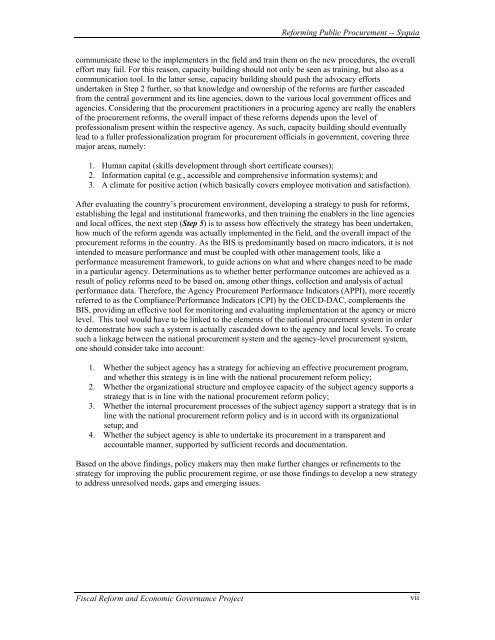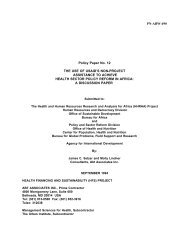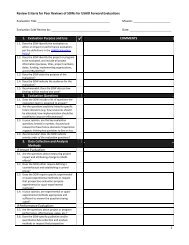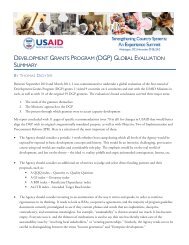Reforming Public Procurement in Emerging Market ... - KDID Portal
Reforming Public Procurement in Emerging Market ... - KDID Portal
Reforming Public Procurement in Emerging Market ... - KDID Portal
Create successful ePaper yourself
Turn your PDF publications into a flip-book with our unique Google optimized e-Paper software.
<strong>Reform<strong>in</strong>g</strong> <strong>Public</strong> <strong>Procurement</strong> -- Syquia<br />
communicate these to the implementers <strong>in</strong> the field and tra<strong>in</strong> them on the new procedures, the overall<br />
effort may fail. For this reason, capacity build<strong>in</strong>g should not only be seen as tra<strong>in</strong><strong>in</strong>g, but also as a<br />
communication tool. In the latter sense, capacity build<strong>in</strong>g should push the advocacy efforts<br />
undertaken <strong>in</strong> Step 2 further, so that knowledge and ownership of the reforms are further cascaded<br />
from the central government and its l<strong>in</strong>e agencies, down to the various local government offices and<br />
agencies. Consider<strong>in</strong>g that the procurement practitioners <strong>in</strong> a procur<strong>in</strong>g agency are really the enablers<br />
of the procurement reforms, the overall impact of these reforms depends upon the level of<br />
professionalism present with<strong>in</strong> the respective agency. As such, capacity build<strong>in</strong>g should eventually<br />
lead to a fuller professionalization program for procurement officials <strong>in</strong> government, cover<strong>in</strong>g three<br />
major areas, namely:<br />
1. Human capital (skills development through short certificate courses);<br />
2. Information capital (e.g., accessible and comprehensive <strong>in</strong>formation systems); and<br />
3. A climate for positive action (which basically covers employee motivation and satisfaction).<br />
After evaluat<strong>in</strong>g the country’s procurement environment, develop<strong>in</strong>g a strategy to push for reforms,<br />
establish<strong>in</strong>g the legal and <strong>in</strong>stitutional frameworks, and then tra<strong>in</strong><strong>in</strong>g the enablers <strong>in</strong> the l<strong>in</strong>e agencies<br />
and local offices, the next step (Step 5) is to assess how effectively the strategy has been undertaken,<br />
how much of the reform agenda was actually implemented <strong>in</strong> the field, and the overall impact of the<br />
procurement reforms <strong>in</strong> the country. As the BIS is predom<strong>in</strong>antly based on macro <strong>in</strong>dicators, it is not<br />
<strong>in</strong>tended to measure performance and must be coupled with other management tools, like a<br />
performance measurement framework, to guide actions on what and where changes need to be made<br />
<strong>in</strong> a particular agency. Determ<strong>in</strong>ations as to whether better performance outcomes are achieved as a<br />
result of policy reforms need to be based on, among other th<strong>in</strong>gs, collection and analysis of actual<br />
performance data. Therefore, the Agency <strong>Procurement</strong> Performance Indicators (APPI), more recently<br />
referred to as the Compliance/Performance Indicators (CPI) by the OECD-DAC, complements the<br />
BIS, provid<strong>in</strong>g an effective tool for monitor<strong>in</strong>g and evaluat<strong>in</strong>g implementation at the agency or micro<br />
level. This tool would have to be l<strong>in</strong>ked to the elements of the national procurement system <strong>in</strong> order<br />
to demonstrate how such a system is actually cascaded down to the agency and local levels. To create<br />
such a l<strong>in</strong>kage between the national procurement system and the agency-level procurement system,<br />
one should consider take <strong>in</strong>to account:<br />
1. Whether the subject agency has a strategy for achiev<strong>in</strong>g an effective procurement program,<br />
and whether this strategy is <strong>in</strong> l<strong>in</strong>e with the national procurement reform policy;<br />
2. Whether the organizational structure and employee capacity of the subject agency supports a<br />
strategy that is <strong>in</strong> l<strong>in</strong>e with the national procurement reform policy;<br />
3. Whether the <strong>in</strong>ternal procurement processes of the subject agency support a strategy that is <strong>in</strong><br />
l<strong>in</strong>e with the national procurement reform policy and is <strong>in</strong> accord with its organizational<br />
setup; and<br />
4. Whether the subject agency is able to undertake its procurement <strong>in</strong> a transparent and<br />
accountable manner, supported by sufficient records and documentation.<br />
Based on the above f<strong>in</strong>d<strong>in</strong>gs, policy makers may then make further changes or ref<strong>in</strong>ements to the<br />
strategy for improv<strong>in</strong>g the public procurement regime, or use those f<strong>in</strong>d<strong>in</strong>gs to develop a new strategy<br />
to address unresolved needs, gaps and emerg<strong>in</strong>g issues.<br />
Fiscal Reform and Economic Governance Project<br />
vii







